Suzuki Swift
Purpose:
Here is a guide to help you distinguish between different model Swifts, and what options were available on which models. This is by no means a definitive guide, and will be updated with more detailed information over time.
MK1 - SA310 / SA413 (1984-86)
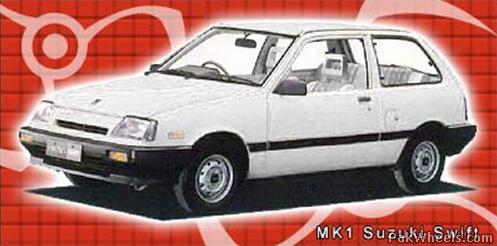
Introduced to Australia in March 1984, the Swift started off as a cheap econobox, available as a 1 litre 3 door van until the full range was introduced in 1986. The SA Swift was front wheel drive, with a solid axle and drum brakes on the rear, with disc brakes on the front. A lot of components were sourced from the Suzuki Hatch format vehicle, including the 12" wheels.
GA, GL, GC and GLS:
The base models GA and GL were available with 1 litre G10A SOHC engine, with the GL having the option of a G13A 1.3 SOHC. Both power plants were naturally aspirated via a carburetor. The 5 door GC model, although stylistically the same as the 3 door hatch, had a longer chassis, with smaller front doors to allow for the rear doors. Optional extras on these models included air conditioning.
GTi:
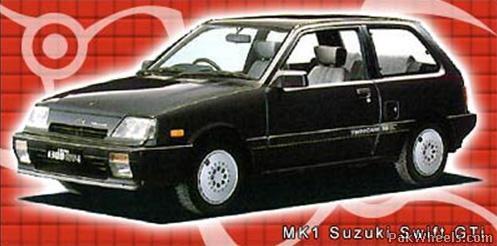
In 1986, Suzuki released the performance oriented Swift GTi into the Australian market. Available only as a 3 door hatch with a 5 speed manual gearbox, the GTi featured the G13B engine, a 1.3 litre, double overhead cam, multipoint fuel injected motor, good for 74kw at the front wheels. Exterior styling boasted larger, lower front and rear bars, incorporating fog lights on the front. Side skirts were also fitted, as well as larger 13" wheels to round off the enhanced suspension package. Interior upgrades from other models included sports seating and steering wheel, and a tachometer incorporated into the instrument cluster, along with power mirrors. The SA was the smallest and lightest of all GTi Swifts.
As a side note, a number of the final SA GTI's to run of the production line contained many components from the soon to be released SF model.
MK2 - SF310 / SF413 / SF416 (1989-92)
1989 saw the end of the "boxy" SA model Swift, and the introduction of the all new rounder shape SF MK2. Although the mechanics and driveline remained similar to the SA model, the body was all new, and much bigger. The solid rear axle was replaced with a trailing arm setup, and wheel sizes were increased.
The range included the base model 3 door GA and GL, and the performance flagship GTi. The SF also saw the Swift range extended to include the GL and GLX Sedan, which came with the option of a 1.6L EFI engine and 4WD. (4WD available between 1990-91)
GA and GL:
The base models in the Swift range, both were equipped with a 1.0 Litre G10A engine and 5 speed gearbox, with the option of an automatic transmission available for the GL. The G10A produced 39kw at the flywheel. Exterior styling was limited to grey front and rear front bars. Air conditioning was an optional extra.
Sedan: - GL and GLX (including 4WD)
As an alternative to the 3 door hatchback, Suzuki introduced the Sedan, based on the chassis of the later to be introduced 5 door Cino. Available with two choices of engines, the GL was fitted with the G13BA SOHC carburettored engine pushing 50kw, and the GLX was powered by the G16BA SOHC with throttle body fuel injection, pumping out a healthy 70kw at the flywheel. Standard equipment on the GLX included central locking, a tachometer, and rear fog lights. Optional extras on the Sedan included air conditioning and a "Power Pack", which included power windows, power steering, and front fog lights.
The Swift Sedan was also available as a 4 wheel drive variant between 1990-1991, but was discontinued due to slow sales compared to the GTi. The 4WD utilised technology from the Japanese specification Cultus, including a cable select gearbox and viscous coupling.
GTi:
The GTi was the top-spec model in the Swift performance range, and this was reflected by the list of inclusions, both performance and cosmetic. Although retaining the same shell and fundamentals as the base models, the GTi received the full treatment from Suzuki. Exterior additions included unique body coloured front and rear bars, side skirts, rear wing, and rear view mirrors on both sides. Also added were front fog lights, and a rear window wiper/washer.
On the inside, the GTi was fitted with a sports steering wheel, seats licensed by Recaro, differently styled rear seats, an instrument cluster including a tachometer, and cloth inserts in the door trims. Other inclusions were items such as power mirrors and a remote hatch/petrol filler release.
But the real heart of the GTi's spirit was beneath the bodywork.
Lurking beneath the bonnet was the G13B 1.3L DOHC engine, fitted with multi-point injection and good for 74kw (100HP) at the flywheel.
This was coupled to a short ratio 5 speed gearbox and fed to the ground through larger 14" wheels and tyres.
Also upgraded from the base model were the brakes, which comprised larger rotors and calipers on the front, and the addition of disc brakes on the rear. Another additional item was a rear 15mm sway bar.
The only optional extra on the GTi was air conditioning. Power steering was not available.
MK3 - SF310 / SF413 / SF416 (1993-99)
The final incarnation of the Swift in Australia saw some cosmetic upgrades, including a remodeled interior, an overhaul of the front and rear bars, and the replacement of the MK2 "mesh style" rear lights with a smoother flush-fitting set, which incorporated reversing lights. This change also included a matching centre panel, with the number plate being relocated to the rear bar.
The dashboard was completely revised, and was now a more rounded shape, with dial size increased.
Models included the GA, (later replaced with the City Car), the Cino, GL and GLX Sedans, and of course, the GTi
GA / City Car:
The base model GA was carried over from the MK1, but was soon replaced with the City Car designation. Apart from the cosmetic changes associated with the makeover of all MK2 Swifts, this model remained unchanged and featured the 1 litre G10A engine.
Cino / Extreme:
In order to better compete with other small cars emerging in the Australian market, and to appeal to potential buyers, Suzuki released the Suzuki (Swift) Cino. Available as a 3 or 5 door hatch, externally the Cino was fitted with the same colour coded front and rear bars as the MK3 GTi, although with air vents in place of the fog lights. Internally, the Cino received a slightly updated interior, including a new steering wheel and trimmings. Mechanically, the Cino engine was the carby-fed G13BA 1.3 litre SOHC.
During the later years of the Cino, Suzuki released the Cino Extreme in NSW and the ACT. The Extreme was based on the Cino 3 door, but was fitted with many more components shared with the GTi. Outside, side skirts were fitted to match the GTi front and rear bars, the mirrors were colour coded, and Xtreme stickers were applied. Interior upgrades involved upgrading everything to GTi specifications, including seats, power windows and instruments. Mechanical performance however was not improved, and the Extreme still featured the Cino's suspension, G13BA carburetor motor and drum rear brakes.
Air conditioning and power steering were optional.
Sedan: (GL and GLX)
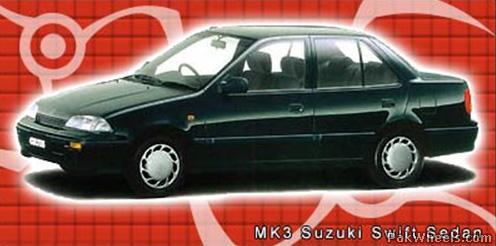
With the introduction of the MK3 series Swift, Suzuki dropped the 4WD Sedan from the lineup, and continued to produce the 1.3 GL and 1.6i GLX models. Although the Sedan's body remained unchanged, it did receive restyled front and rear bars (GLX's were colour coded), along with the same interior upgrades as all other models, including the interior.
GTi:
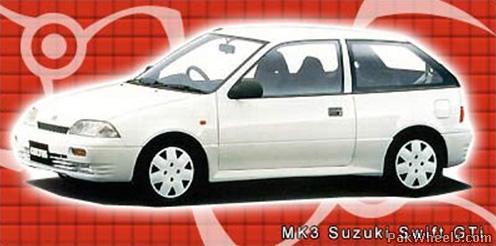
Like all MK3 Swifts, the GTi received the same exterior styling updates, along with a number of other changes.
Power windows were now fitted as standard, and the interior now contained a new steering wheel, as well as an instrument cluster that included a tachometer.
Mechanically, the engine remained the same, however the ECU was modified with a different map.
The inclusion of power windows and some other changes make the MK3 GTi the heaviest of all Swift hatchbacks.
Other Swift Exports
MK4 Swift / Swift Sky - European release only (1996-2002)
Much the same as the Australian MK3, the MK4 Swift was extensively remodeled on the exterior, including new headlights, tail lights, front and rear bars, bonnet and quarter panels. However mechanically they remain the same.
Pontiac Firefly - Chevrolet Sprint - Geo Metro - Chevrolet Metro
Released in North America and Canada, these vehicles were based on a similar format and chassis as the Australian Swift. However exterior styling items, such as headlights, tail lights, and front and rear bars were modeled differently.
In contrast to the local domestic Swift, many of these vehicles were equipped with a 1 litre, EFI, SOHC Turbo engine. These are identifiable by an unmistakable scoop on the bonnet.
Suzuki (Swift) Cultus
In some markets (namely Japan) the Suzuki Swift was known as the Suzuki Cultus. Although the Cultus was equipped with the same G13B engine as the domestic Australian Swift, it was fitted with a number of modified parts in order to boost performance to 115HP from the Swifts 100HP.
These components (such as the reverse intake manifold) are much sought after items for Australian Swift modifiers. On the exterior, the hatchback Cultus featured an extra lower wing on the rear, as well as rear fog lights in the center panel that remains unlit on the MK3 Australian Swift.
Some other points worth mentioning are that the Cultus was also available in 4WD configuration, and in later years the "Swift" Cultus was replaced by the vehicle that was badged a Baleno in Australia
Holden Barina - MB (1985-86), ML (1987-88), MF (1989-90), MH (1991-93)
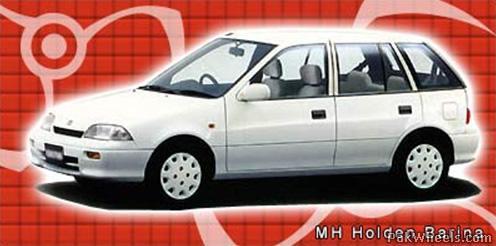
The Suzuki Swift was sold by Holden in Australia as the Barina. There were several different configurations released, most of which coincided with equivalent Swift models, with the only differences being the Holden badges and compliance plate.
MB/ML models were the equivalent to the MK1 Swift, the MF was the MK2, and the MH the same as a MK3. Some slight differences between Holden and Suzuki counterparts, were that Barina's were all fitted with rear window wiper/washers, but no passengers side mirror.
All Barina's were fitted with the Suzuki G13BA SOHC carburetor engine.
Although Holden entered into contract with Suzuki to develop and release the Swift/Barina in Australia, they did not release a version of the GTi. Holden did, however, release a GS model of the 2 door MF/MH Barina, which featured GTi front and rear bars (minus side skirts), and twin rear view wing mirrors, with distinctive pin-striping on the body.
The interior of the GS featured GTi seats, steering wheel, instrument cluster, and remote fuel/hatch release.
Unlike the GTi, the GS did not contain any performance modifications, and retained a drum brake rear end and the G13BA engine.
In reality, the GS Barina is more closely related to the Cino Extreme than the Swift GTi.